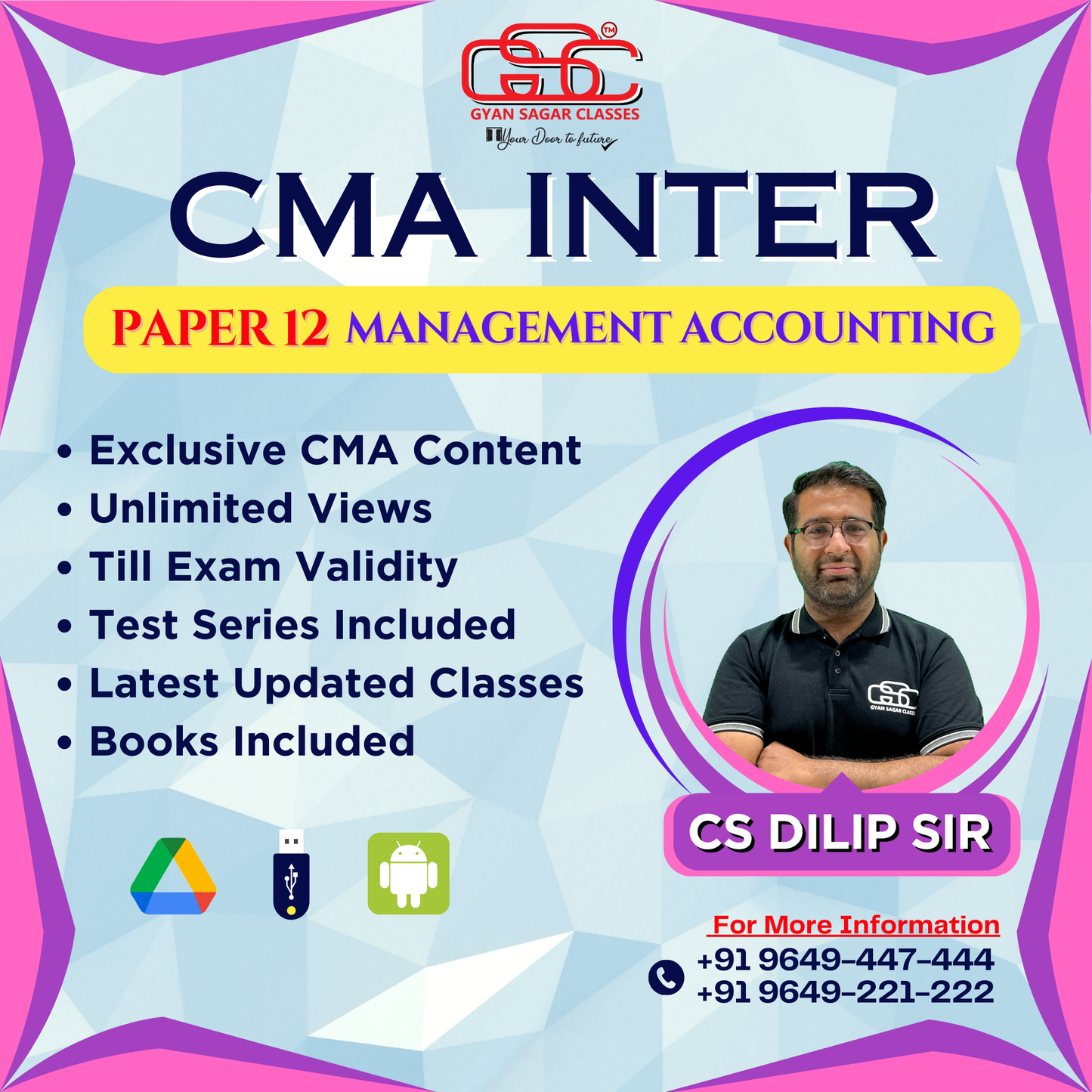CMA Cart
CMA Inter Management Accounting (MA)
CMA Inter Management Accounting (MA)
Couldn't load pickup availability
Product Information
| Mode |
Download Link with Hard-Book
|
| Duration | Lectures:- 110 (Duration:- 90 – 100 Hours) |
| Video Language | Hindi |
| Faculty Name | CS Dilip Sir |
| Course Material Language | English |
| Video Run on | Computer / Laptop / Android Mobile (Video Lectures Do Not Run on Apple Device Please Check FAQ) |
| Study Material | Hard Book |
| Package Details | Video Lectures + Study Material |
| Exams validity | Till Exam |
| Doubt Solving Facility | Email, WhatsApp, Call |
| Delivery Free Delivery | Non Cancellable |
| Product Dispatch | Within 24 to 48 Working Hours |
| Total No. Views | Unlimited Views (Till Exam) |
Content As Per Syllabus
SECTION A: INTRODUCTION TO MANAGEMENT ACCOUNTING
Module 1. Introduction to Management Accounting 1.1 Conceptual Understanding 1.2 Relationship between Management Accounting and Cost Accounting 1.3 Role of a Management Accountant in Modern Business WorldSECTION B: ACTIVITY BASED COSTING
Module 2. Activity Based Costing 2.1 Traditional Cost System 2.2 Definition and Meaning of Activity Based Costing (ABC) 2.3 Steps in ABC System 2.4 Cost Pools and Cost Drivers 2.5 Merits and Demerits of ABC System 2.6 Activity Based Information and Decision MakingSECTION C: DECISION MAKING TOOLS
Module 3. Marginal Costing 3.1 Concept 3.2 Cost-Volume-Profit Analysis 3.3 Break-Even Charts and Profit Charts 3.4 Multiple Product Break Even Analysis 3.5 Differential Cost Analysis 3.6 Marginal Costing Vs. Absorption Costing (advanced applications)
Module 4. Applications of Marginal Costing in Short Term Decision Making 4.1 Pricing Decision 4.2 Make or Buy decisions 4.3 Accept an Order or Reject 4.4 Optimum Utilization of Factors of Production [Limiting Factor Analysis] 4.5 Replacement Decision 4.6 Evaluation of Alternative Choices 4.7 Subcontracting and Ancillarisation 4.8 Expansion of Business 4.9 Shutdown or Continue
Module 5. Transfer Pricing 5.1 Concept 5.2 Methods and Techniques 5.3 Divisional Performance and Problem of Goal Congruence 5.4 Determination of Inter-departmental or Inter-company Transfer Price 5.5 International Transfer Pricing
SECTION D: STANDARD COSTING AND VARIANCE ANALYSIS
Module 6. Standard Costing and Variance Analysis 6.1 Material and Labour Variances 6.2 Variable Overhead Variance 6.3 Fixed Overhead Variance 6.4 Sales Variance 6.5 Interpretation of Variances and Inferences DrawnSECTION E: FORECASTING, BUDGETING AND BUDGETARY CONTROL
Module 7. Forecasting, Budgeting and Budgetary Control 7.1 Introduction 7.2 Rationale for Budgets 7.3 General principles in the Budgetary process 7.4 Formulation of various types of BudgetsSECTION F: DIVISIONAL PERFORMANCE MEASUREMENT
Module 8. Divisional Performance Measurement 8.1 Organisations with Multiple divisions, Benefits of Decentralization 8.2 DuPont Analysis 8.3 Divisional Performance Measurement tools – ROI, Residual Income 8.4 Economic Value Added – Definition, EVA Centre, EVA Drivers 8.5 Introduction to Learning Curve 8.6 Balanced Score Card for Variable Pay ManagementSECTION G: RESPONSIBILITY ACCOUNTING
Module 9. Responsibility Accounting 9.1 Concept of Cost, Revenue, Profit and Responsibility Centres 9.2 Preparation of Responsibility ReportSECTION H: DECISION THEORY
Module 10. Decision Theory 10.1 Decision Making under Certainty 10.2 Decisions Making under Risk 10.3 Decision Making under Uncertainty 10.4 Decision TreeShare


